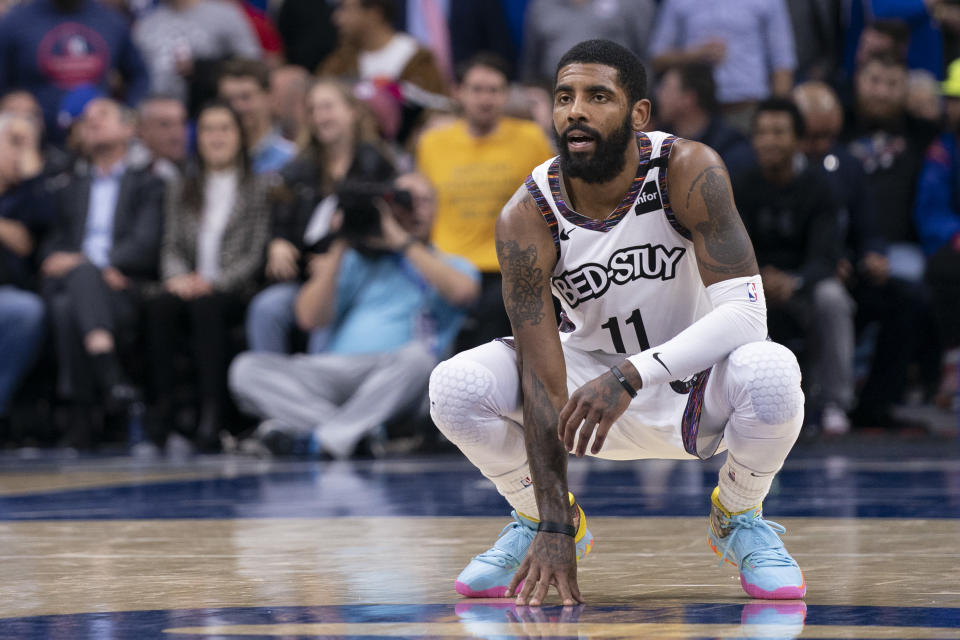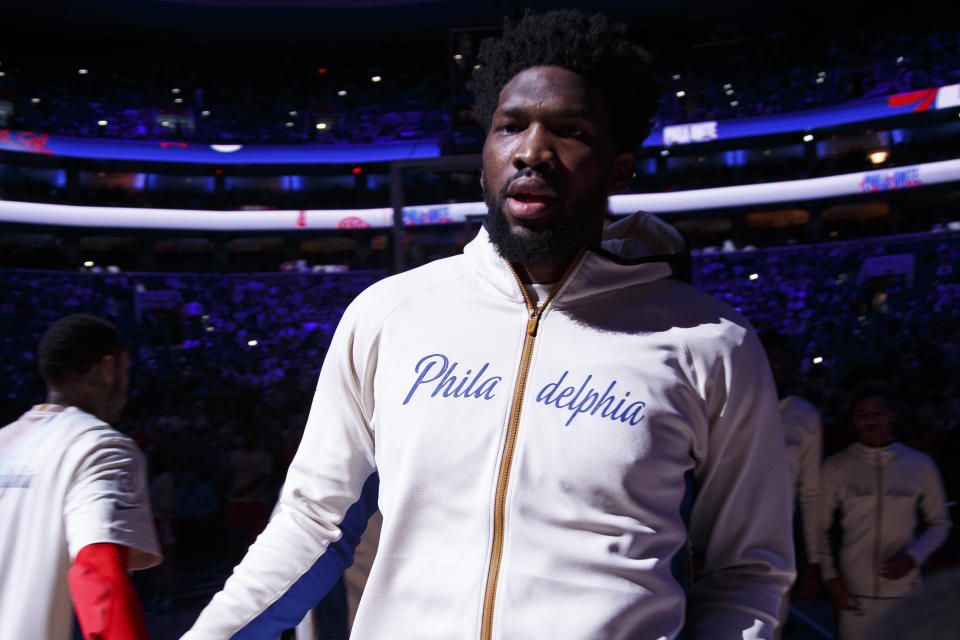Kyrie Irving is back and trying to lead the Nets — for better or worse
Our weekly look at four topics — players, issues, numbers, trends — that are impacting and, in some cases, changing the game.
First Quarter: Kyrie and culture
Oh, Kyrie.
His talent is obvious.
Everything else is a blur, subject to interpretation.
Kyrie Irving spent two months on the sidelines, watching the Brooklyn Nets adjust without him to mixed results. Then when he returned in a predictable win against the Atlanta Hawks, he gave his observations of the team he had just re-joined.
“There’s more teaching to be done,” he said. “Specifically for our younger players. We’re still building what the Brooklyn Nets culture is. That’s yet to be defined. We have a chance to define it, the guys in the locker room here. Obviously we play hard here, but we want to be a championship-level organization. We want to be that for the next few years and that’s competing, and even when I’m done playing basketball, that this culture here be consistent. That’s what I’m after.”

On its face, there’s nothing wrong with that.
Irving is a made man, a champion, an Olympian and generally regarded as one of the best in-game pressure players this league has to offer.
But giving lectures on culture is a bit tough to swallow, especially when he doesn’t have the sweat equity with this franchise.

It’s unclear how Irving defines a winning culture, even though he’s played for two contending franchises. He forced his way out of Cleveland, a place that if nothing else had a championship player (LeBron James) but possibly championship accountability, too. Irving clearly bristled at the way things were done or, at the least, the way everything revolved around James.
Fair enough.
When Irving got to Boston, his public missteps occurred as the Celtics underachieved, and Irving, again, voiced his displeasure about the way things were run. Whether it was too many young players with responsibility or too much ambiguity from the front office about the future, things fell apart and Irving wore a share of the blame.
Danny Ainge and Brad Stevens escaped from criticism unscathed, but let’s digress.
Either way, it wasn’t a culture Irving wanted to be part of even though the Celtics have routinely been successful in the East recently.
So what “culture” does Irving speak of when referring to what he wants to build in Brooklyn? In hindsight, he’s appeared to take a level of responsibility, calling James to clear the air, and upon his arrival in Brooklyn, offering a Media Day mea culpa for what went wrong in Boston.
But he wasn’t happy in either of the situations that many would deem successful, and before James returned to Cleveland, Irving wasn’t leading the Cavaliers anywhere.
Yet it would be unfair to hold him to labels planted as an early 20-something, especially as he’s gotten more experienced.
But is it the time or place to put the spotlight on young players who kept the ship afloat in your absence, and a culture that seemed to work to some degree the year before when the Nets made an unexpected run to the postseason?
Did he take things from the Celtics’ and Cavaliers’ cultures he’d want to have a part in implementing when Kevin Durant gets back on the floor, presumably next season?
Possibly.
But it’s hard to give him the benefit of the doubt as a leader when the evidence shows his words deserve scrutiny. You can want him on your team, taking and making big shots, but your leadership had better be sound, mature and in order.
He’s certainly an easy target and some of his actions have been followed by heavy-handed criticism that didn’t seem complete or fair at the time. He followed his comments after the Hawks game with a statement about what the Nets need to compete following an 11-point loss to the 76ers on Wednesday night.
“I mean, it’s transparent. It’s out there,” he told reporters. “It’s glaring, in terms of some of the pieces that we need in order to be successful at the next level. I’m going to continue to reiterate it. We’re doing the best we can with the guys we have in the locker room now, and we’ll worry about the other stuff, in terms of moving pieces and everything else, as an organization down the line in the summer.”
When Kyrie arrives at your doorstep, a lot comes with him — mainly his brand of critique. The Nets better be equipped for everything else.
Second Quarter: The MVP race
It’s the halfway mark for several teams, which means we can reasonably assess candidates for Most Valuable Player. Here’s my ballot to date:
Giannis Antetokounmpo, Milwaukee Bucks (30 points, 12.7 rebounds, 5.5 assists): The MVP got better, and the Bucks are an even more formidable regular-season bunch than last year. Ridiculous production from a guy who didn’t have to take the regular season seriously.
LeBron James, Los Angeles Lakers (25.4 points, 10.9 assists, 7.7 rebounds): Who believed him when he said Anthony Davis would be the leader on this team? It’s always LeBron’s team, molded in his image. Sliding over to point guard only solidifies a Lakers team intent on clinching home court through the West.
Luka Doncic, Dallas Mavericks (28.8 points, 9.8 rebounds, 9.4 assists): Someone check that man’s birth certificate! Playing with a pace beyond his years, he’s thrust the Mavs into playoff contention when not much was expected.
Jimmy Butler, Miami Heat (20.5 points, 6.9 rebounds, 6.4 assists): It’s about winning more than numbers. No player has better exerted his personality on his team than Butler. Second in the East with him; in turmoil or inconsistency without him (see 76ers, Bulls).
Anthony Davis, Los Angeles Lakers (27.1 points, 9.4 rebounds, 2.6 blocks): We’re finally seeing a wondrous talent play meaningful basketball. Davis is nestled comfortably as LeBron’s wing man without allowing his production to be diminished — not an easy role.

Third Quarter: Big men selling shoes?
Selling shoes is an inexact science. The business is booming, but the value of having someone’s signature shoe doesn’t carry the weight it once did. And it’s always a tough task when you look at big men selling shoes — unless you’re Charles Barkley, who had an insane Nike line in the mid-’90s with the Air Max CB2 and the Air Force Max models (look em up!).
Shaquille O’Neal couldn’t move the needle as a shoe spokesman the way he could his other endeavors. David Robinson’s neighborhood was pretty funny for Nike, but his personality wasn’t expressive enough to really market a shoe campaign around.
The 76ers’ Joel Embiid is hoping to buck that trend for Under Armour.
“During the design process, Joel relayed what mattered most to him," Under Armour stated in a release, "a sneaker that could handle a versatile player capable of draining buckets from beyond the arc when they want, and posterizing the competition in the paint when they need. By studying Embiid's shooting form and mobility on the court, the UA team engineered a positionless shoe intended to help any player — from the 5 to the 1 — perform better than the jerseys across from them.”
It’s hard for big men to sell shoes — mostly because kids are the market and it’s hard for youngsters to see themselves as a 7-footer — hence the “from the 5 to the 1” part of the release. But Embiid is witty, active on social media and generally an entertaining player who’s popular across the board.
A few years ago, Stephen Curry’s line made an unexpected dent in the Nike-dominated market when his popularity was at its peak. Under Armour is making a similar bet on an unconventional superstar yet again.
Fourth quarter: ‘Old man yelling at cloud’ alert
ESPN stats guru Kirk Goldsberry posted a chart comparing where the game is played now compared to the start of the millennium, illustrating the top 200 shot locations this season versus 2001-02.
It looks like a force-field was formed around the 3-point line in the current incarnation, with an opening around the dotted line in the lane. The game today is simple: threes en masse or shots at the rim.
In 2001-02, there was a lot more variety, especially midrange shots — the ones marked with a scarlet letter today. The most glaring difference was the disappearance of the baseline jumper, which was used by the likes of Michael Jordan and Hakeem Olajuwon to do serious damage in their primes (albeit not in 2002).
Scoring is up, and the game is more efficient than ever. Eschewing the foot-on-the-line twos isn’t a bad thing, but it shows players aren’t taught to use the entire floor anymore. It seems like a race from 3-point line to 3-point line.
There’s nothing wrong with playing smarter basketball. Three is worth more than two, and if you employ shooters like Stephen Curry, Klay Thompson or Trae Young, you should maximize the best of their gifts.
But those types are few and far between.
For instance, how much more dangerous would Giannis Antetokounmpo be if he mastered that 15-18 foot baseline fade? The current illegal defense rules make it a bit tougher because teams can zone up, but it would be impossible to double the MVP from any part of the floor and it feels like a more natural progression than trying to become a 3-point shooter.
Efficiency is “better,” but not always more entertaining or effective.
Rant over.
More from Yahoo Sports:

 Yahoo Finance
Yahoo Finance 
